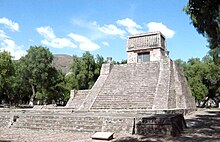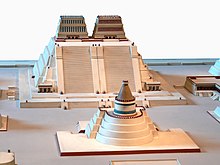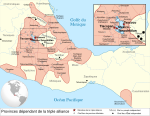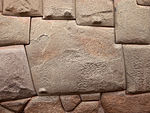
Ahuitzotl was the eighth Aztec ruler, the Huey Tlatoani of the city of Tenochtitlan, son of princess Atotoztli II. His name literally means "Water Thorny" and was also applied to the otter. It is also theorized that more likely, the animal called ahuitzotl is actually the water opossum, the hand symbolizing its prehensile tail, which otters notably lack.

Tenochtitlan, also known as Mexico-Tenochtitlan, was a large Mexican altepetl in what is now the historic center of Mexico City. The exact date of the founding of the city is unclear, but the date 13 March 1325 was chosen in 1925 to celebrate the 600th anniversary of the city. The city was built on an island in what was then Lake Texcoco in the Valley of Mexico. The city was the capital of the expanding Aztec Empire in the 15th century until it was captured by the Tlaxcaltec and the Spanish in 1521.

A chacmool is a form of pre-Columbian Mesoamerican sculpture depicting a reclining figure with its head facing 90 degrees from the front, supporting itself on its elbows and supporting a bowl or a disk upon its stomach. These figures possibly symbolised slain warriors carrying offerings to the gods; the bowl upon the chest was used to hold sacrificial offerings, including pulque, tamales, tortillas, tobacco, turkeys, feathers, and incense. In Aztec examples, the receptacle is a cuauhxicalli. Chacmools were often associated with sacrificial stones or thrones. The chacmool form of sculpture first appeared around the 9th century AD in the Valley of Mexico and the northern Yucatán Peninsula.

The Aztecs were a Mesoamerican culture that flourished in central Mexico in the post-classic period from 1300 to 1521. The Aztec people included different ethnic groups of central Mexico, particularly those groups who spoke the Nahuatl language and who dominated large parts of Mesoamerica from the 14th to the 16th centuries. Aztec culture was organized into city-states (altepetl), some of which joined to form alliances, political confederations, or empires. The Aztec Empire was a confederation of three city-states established in 1427: Tenochtitlan, city-state of the Mexica or Tenochca, Texcoco, and Tlacopan, previously part of the Tepanec empire, whose dominant power was Azcapotzalco. Although the term Aztecs is often narrowly restricted to the Mexica of Tenochtitlan, it is also broadly used to refer to Nahua polities or peoples of central Mexico in the prehispanic era, as well as the Spanish colonial era (1521–1821). The definitions of Aztec and Aztecs have long been the topic of scholarly discussion ever since German scientist Alexander von Humboldt established its common usage in the early 19th century.

In Aztec religion, Coyolxāuhqui is a daughter of the priestess Cōātlīcue. She was the leader of her brothers, the Centzon Huitznahua. She led her brothers in an attack against their mother, Cōātlīcue, when they learned she was pregnant, convinced she dishonored them all. The attack is thwarted by Coyolxāuhqui's other brother, Huitzilopochtli, the national deity of the Mexicas.
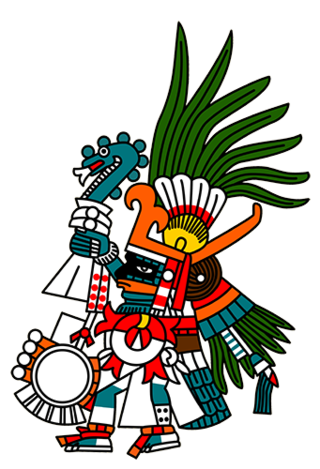
Huitzilopochtli is the solar and war deity of sacrifice in Aztec religion. He was also the patron god of the Aztecs and their capital city, Tenochtitlan. He wielded Xiuhcoatl, the fire serpent, as a weapon, thus also associating Huitzilopochtli with fire.

Acamapichtli was the first Tlatoani, or king, of the Aztecs of Tenochtitlan, and founder of the Aztec imperial dynasty. Chronicles differ as to the dates of his reign: according to the Codex Chimalpahin, he reigned from 1367 to 1387; according to the Codex Aubin, he reigned from 1376 to 1395; and according to the Codex Chimalpopoca, he reigned from 1350 to 1403.

Itzcoatl (1380–1440) was the fourth king of Tenochtitlan, and the founder of the Aztec Empire, ruling from 1427 to 1440. Under Itzcoatl the Mexica of Tenochtitlan threw off the domination of the Tepanecs and established the Triple Alliance together with the other city-states Tetzcoco and Tlacopan.

Cempoala or Zempoala is an important Mesoamerican archaeological site located in the municipality of Úrsulo Galván in the Mexican state of Veracruz. The site was inhabited mainly by Totonacs, Chinantecas and Zapotecs. It was one of the most important Totonac settlements during the postclassical Mesoamerican period and the capital of the kingdom of Totonacapan. It is located one kilometer from the shore of the Actopan River and six kilometres from the coast.

The Templo Mayor was the main temple of the Mexica people in their capital city of Tenochtitlan, which is now Mexico City. Its architectural style belongs to the late Postclassic period of Mesoamerica. The temple was called Huēyi Teōcalli in the Nahuatl language. It was dedicated simultaneously to Huitzilopochtli, god of war, and Tlaloc, god of rain and agriculture, each of which had a shrine at the top of the pyramid with separate staircases. The central spire was devoted to Quetzalcoatl in his form as the wind god, Ehecatl. The Great Temple devoted to Huitzilopochtli and Tlaloc, measuring approximately 100 by 80 m at its base, dominated the Sacred Precinct. Construction of the first temple began sometime after 1325, and it was rebuilt six times. The temple was almost totally destroyed by the Spanish in 1521, and the Mexico City cathedral was built in its place.

The Calmecac was a school for the sons of Aztec nobility in the Late Postclassic period of Mesoamerican history, where they would receive rigorous training in history, calendars, astronomy, religion, economy, law, ethics and warfare. The two main primary sources for information on the calmecac and telpochcalli are in Bernardino de Sahagún's Florentine Codex of the General History of the Things of New Spain and part 3 of the Codex Mendoza.

The Aztec religion is a polytheistic and monistic pantheism in which the Nahua concept of teotl was construed as the supreme god Ometeotl, as well as a diverse pantheon of lesser gods and manifestations of nature. The popular religion tended to embrace the mythological and polytheistic aspects, and the Aztec Empire's state religion sponsored both the monism of the upper classes and the popular heterodoxies.

Human sacrifice was common in many parts of Mesoamerica, so the rite was nothing new to the Aztecs when they arrived at the Valley of Mexico, nor was it something unique to pre-Columbian Mexico. Other Mesoamerican cultures, such as the Purépechas and Toltecs, and the Maya performed sacrifices as well and from archaeological evidence, it probably existed since the time of the Olmecs, and perhaps even throughout the early farming cultures of the region. However, the extent of human sacrifice is unknown among several Mesoamerican civilizations. What distinguished Aztec practice from Maya human sacrifice was the way in which it was embedded in everyday life. These cultures also notably sacrificed elements of their own population to the gods.

Mesoamerican architecture is the set of architectural traditions produced by pre-Columbian cultures and civilizations of Mesoamerica, traditions which are best known in the form of public, ceremonial and urban monumental buildings and structures. The distinctive features of Mesoamerican architecture encompass a number of different regional and historical styles, which however are significantly interrelated. These styles developed throughout the different phases of Mesoamerican history as a result of the intensive cultural exchange between the different cultures of the Mesoamerican culture area through thousands of years. Mesoamerican architecture is mostly noted for its pyramids, which are the largest such structures outside of Ancient Egypt.

The Coatlicue statue is one of the most famous surviving Aztec sculptures. It is a 2.52 metre (8.3 ft) tall andesite statue by an unidentified Mexica artist. Although there are many debates about what or who the statue represents, it is usually identified as the Aztec deity Coatlicue ("Snakes-Her-Skirt"). It is currently located in the National Museum of Anthropology in Mexico City. Originally displayed in the Mexica city of Tenochtitlan, the monumental statue was buried after the 1521 Spanish conquest of the city, and it was excavated roughly 270 years later in 1790.

The Coyolxāuhqui Stone is a carved, circular Aztec stone, depicting the mythical being Coyolxāuhqui ("Bells-Her-Cheeks"), in a state of dismemberment and decapitation by her brother, the patron deity of the Aztecs, Huitzilopochtli. It was rediscovered in 1978 at the site of the Templo Mayor of Tenochtitlan, now in Mexico City. This relief is one of the best known Aztec monuments and one of the few great Aztec monuments that have been found fully in situ.
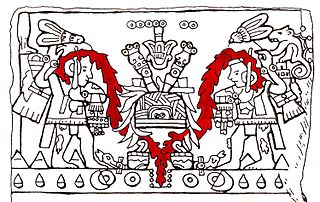
The Dedication Stone of the CGZ age is a carved Aztec plaque made of polished greenstone. The plaque was found in 1845 in the location of present-day Mexico City. This plaque was made in commemoration of the completion of the sixth stage the Temple of Huitizilopochtli at Tenochtitlan in 1487. The dedication of the refurbished Great Temple was the final ceremony in becoming the emperor. Tizoc ruled from 1481 until 1486, after his death his brother Ahuitzotl succeeded him and ruled from 1486 until 1502. Expanding the Great Temple of Tenochtitlan, dedicated to the gods Huitzilopochtli and Tlaloc, was the duty of each tlatoani. Tizoc began the expansion of the Great Temple and his brother Ahuitzotl finished the project. According to the Codex Mendoza this was an important time for the Aztec society, they became an imperial civilization, with Ahuitzotl conquering 45 new towns. The ceremony of the re-dedication of the Temple involved so many sacrifices that the ceremony lasted for four days. Where this panel was located originally is unknown. Other panels similar to this one were usually placed into the architecture like stairways and pyramid platforms. Very similar stones have been found at the Great Temple of Tenochtitlan also known as the Templo Mayor and it is believed that this plaque might have been a part of those.

Acatitlan is an archeological zone of the early Aztec culture located in the town of Santa Cecilia, in the municipality of Tlalnepantla de Baz in the State of Mexico, about 10 km northwest of Mexico City. In pre-Columbian times, it was located on the northwest shore of the great Lake Texcoco.

Tenayuca is a pre-Columbian Mesoamerican archaeological site in the Valley of Mexico. In the Postclassic period of Mesoamerican chronology, Tenayuca was a settlement on the former shoreline of the western arm of Lake Texcoco. It was located approximately 10 kilometres (6.2 mi) to the northwest of Tenochtitlan.

The Atlantean figures are four anthropomorphic statues belonging to the Toltec culture in pre-Columbian Mesoamerica. These figures are "massive statues of Toltec warriors". They take their post-Columbian name from the European tradition of similar Atlas or Atalante figures in classical architecture.
